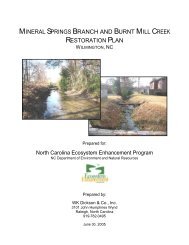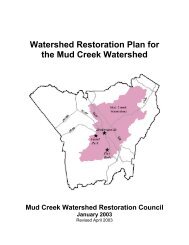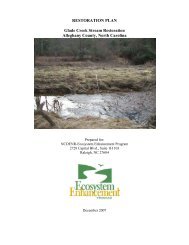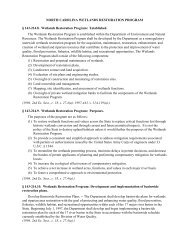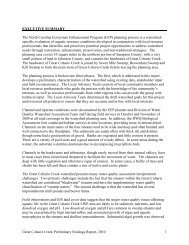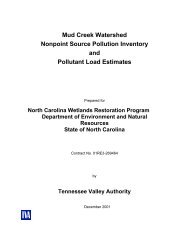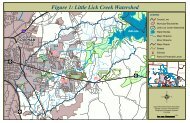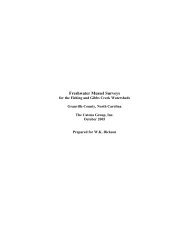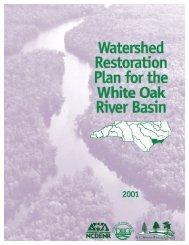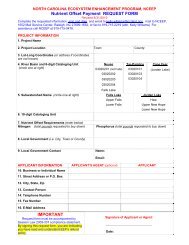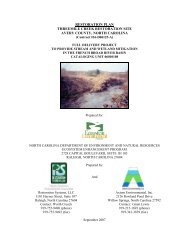MITIGATION PLAN Burnetts Chapel Buffer Mitigation Site Guilford ...
MITIGATION PLAN Burnetts Chapel Buffer Mitigation Site Guilford ...
MITIGATION PLAN Burnetts Chapel Buffer Mitigation Site Guilford ...
Create successful ePaper yourself
Turn your PDF publications into a flip-book with our unique Google optimized e-Paper software.
<strong>MITIGATION</strong> <strong>PLAN</strong><br />
<strong>Burnetts</strong> <strong>Chapel</strong> <strong>Buffer</strong><br />
<strong>Mitigation</strong> <strong>Site</strong><br />
<strong>Guilford</strong> County, North Carolina<br />
DENR Contract 003996<br />
Randleman Lake Watershed<br />
Cape Fear River Basin<br />
HUC 03030003<br />
Prepared for:<br />
NC Department of Environment and Natural Resources<br />
Ecosystem Enhancement Program<br />
1652 Mail Service Center<br />
Raleigh, NC 27699-1652<br />
February 2012
<strong>MITIGATION</strong> <strong>PLAN</strong><br />
<strong>Burnetts</strong> <strong>Chapel</strong> <strong>Buffer</strong><br />
<strong>Mitigation</strong> <strong>Site</strong><br />
<strong>Guilford</strong> County, North Carolina<br />
DENR Contract 003996<br />
Randleman Lake Watershed<br />
Cape Fear River Basin<br />
HUC 03030003<br />
Prepared for:<br />
NC Department of Environment and Natural Resources<br />
Ecosystem Enhancement Program<br />
1652 Mail Service Center<br />
Raleigh, NC 27699-1652<br />
Prepared by:<br />
Wildlands Engineering, Inc.<br />
1430 South Mint Street, Suite 104<br />
Charlotte, NC 28203<br />
Phone – 704-332-7754<br />
February 2012
EXECUTIVE SUMMARY<br />
The <strong>Burnetts</strong> <strong>Chapel</strong> <strong>Buffer</strong> <strong>Mitigation</strong> <strong>Site</strong> is a full-delivery stream buffer restoration and enhancement<br />
project for the North Carolina Ecosystem Enhancement Program (NCEEP) in <strong>Guilford</strong> County, NC. The<br />
project includes the restoration and enhancement of stream buffers along several unnamed tributaries to<br />
Randleman Lake. The project is being completed to provide buffer mitigation units (BMUs) in the Cape<br />
Fear River Basin and will include 9.2 acres of buffer restoration and 1.5 acres of buffer preservation.<br />
Table ES.1 Project Components<br />
<strong>Burnetts</strong> <strong>Chapel</strong> <strong>Buffer</strong> <strong>Mitigation</strong> <strong>Site</strong><br />
Area<br />
Area A<br />
Area A<br />
Area B<br />
Management Objectives<br />
Restore riparian buffer.<br />
Remove crop production<br />
and nutrient application.<br />
No vegetation management<br />
proposed.<br />
Restore riparian buffer.<br />
Remove crop production<br />
and nutrient application.<br />
Type of<br />
<strong>Mitigation</strong><br />
<strong>Buffer</strong><br />
Restoration<br />
<strong>Buffer</strong><br />
Preservation<br />
<strong>Buffer</strong><br />
Restoration<br />
Area<br />
(acres)<br />
Ratio<br />
<strong>Mitigation</strong><br />
Units<br />
(BMUs)<br />
1.5 1:1 1.5<br />
0.67 N/A 0.0<br />
7.7 1:1 7.7<br />
Area B<br />
No vegetation management<br />
proposed.<br />
<strong>Buffer</strong><br />
Preservation<br />
0.86 N/A 0.0<br />
Total 10.7 acres ‐ ‐ ‐ 9.2 BMUs<br />
The <strong>Burnetts</strong> <strong>Chapel</strong> <strong>Buffer</strong> <strong>Mitigation</strong> <strong>Site</strong> is located in the 03030003 Catalog Unit (CU), in the Cape<br />
Fear River Basin. The Deep River is the primary river in this HUC which flows into the Randleman<br />
Reservoir. The project site streams are direct tributaries to Deep River in the Randleman Reservoir. The<br />
newly created reservoir is a regional water supply and stream buffer protection rules are in place<br />
throughout the watershed (http://portal.ncdenr.org/web/wq/swp/ws/401/riparianbuffers/rules). The Cape<br />
Fear shiner, a federally endangered species, is found in the Deep River. Protection of this species and<br />
improving the water quality of the waters draining to the Randleman Reservoir are included as<br />
recommendations in the NCEEP 2009 Cape Fear River Basin Restoration Priorities Report<br />
(http://www.nceep.net/services/lwps/cape_fear/RBRP%20Cape%20Fear%202008.pdf). The <strong>Burnetts</strong><br />
<strong>Chapel</strong> <strong>Buffer</strong> <strong>Mitigation</strong> <strong>Site</strong> was identified as a buffer mitigation opportunity to improve water quality<br />
and habitat within the CU.<br />
The major goals of the proposed buffer restoration project are to provide ecological and water quality<br />
enhancements to the Randleman Lake watershed of the Cape Fear River Basin by creating a functional<br />
riparian corridor and restoring a Piedmont Bottomland Forest as described by Schafale and Weakley<br />
(1990). Specific enhancements to water quality and ecological processes are outlined below in Table<br />
ES.2.<br />
<strong>Burnetts</strong> <strong>Chapel</strong> <strong>Buffer</strong> <strong>Mitigation</strong> <strong>Site</strong><br />
<strong>Mitigation</strong> Plan<br />
Page i
Table ES.2 Ecological and Water Quality Goals of the <strong>Mitigation</strong> Project<br />
<strong>Burnetts</strong> <strong>Chapel</strong> <strong>Buffer</strong> <strong>Mitigation</strong> <strong>Site</strong><br />
Water Quality Goals<br />
Decrease nutrient and<br />
fecal coliform levels<br />
Decrease sediment input<br />
Decrease water<br />
temperature and<br />
increase dissolved<br />
oxygen concentrations<br />
Create appropriate<br />
terrestrial habitat<br />
Nutrient and fecal coliform input will be decreased by filtering runoff<br />
from the pasture and agricultural fields through restored native buffer<br />
zones. The off‐site nutrient input will also be absorbed on‐site by<br />
filtering flood flows through restored riparian buffer areas, where<br />
flood flows can disperse through native vegetation.<br />
Sediment from off‐site sources will be captured by deposition on<br />
restored riparian areas where native vegetation will slow overland flow<br />
velocities.<br />
Establishment and maintenance of riparian buffers will create longterm<br />
shading of the channel flow to minimize thermal heating.<br />
Ecological Goals<br />
<strong>Buffer</strong> areas will be restored by removing invasive vegetation and<br />
planting native vegetation. Some bank sloping, matting, and planting<br />
will occur in isolated locations. Native vegetation will provide cover<br />
and food for terrestrial creatures.<br />
This mitigation plan has been written in conformance with the requirements of the following:<br />
Federal rule for compensatory mitigation project sites as described in the Federal Register Title<br />
33 Navigation and Navigable Waters Volume 3 Chapter 2 Section § 332.8 paragraphs (c)(2)<br />
through (c)(14).<br />
NCDENR Ecosystem Enhancement Program In-Lieu Fee Instrument signed and dated July 28,<br />
2010.<br />
These documents govern NCEEP operations and procedures for the delivery of compensatory mitigation.<br />
<strong>Burnetts</strong> <strong>Chapel</strong> <strong>Buffer</strong> <strong>Mitigation</strong> <strong>Site</strong><br />
<strong>Mitigation</strong> Plan<br />
Page ii
<strong>Burnetts</strong> <strong>Chapel</strong> <strong>Buffer</strong> <strong>Mitigation</strong> <strong>Site</strong><br />
<strong>Mitigation</strong> Plan<br />
EXECUTIVE SUMMARY ........................................................................................................... i<br />
1.0 Restoration Project Goals and Objectives ..................................................................... 1<br />
2.0 <strong>Site</strong> Selection ............................................................................................................. 1<br />
2.1 Directions ............................................................................................................... 1<br />
2.2 <strong>Site</strong> Selection .......................................................................................................... 1<br />
2.3 Vicinity Map ............................................................................................................ 2<br />
2.4 Watershed Map ...................................................................................................... 2<br />
2.5 Soil Survey ............................................................................................................. 2<br />
2.6 Current Condition Plan View .................................................................................... 3<br />
2.7 Historical Condition Plan View .................................................................................. 3<br />
2.8 <strong>Site</strong> Photographs .................................................................................................... 4<br />
3.0 <strong>Site</strong> Protection Instrument .......................................................................................... 4<br />
3.1 <strong>Site</strong> Protection Instruments Summary Information .................................................... 4<br />
3.2 <strong>Site</strong> Protection Instrument Figure............................................................................. 4<br />
4.0 Baseline Information .................................................................................................. 4<br />
4.1 Watershed Summary Information ............................................................................ 6<br />
4.2 Existing Conditions Summary Information ................................................................ 6<br />
4.3 Regulatory Considerations ....................................................................................... 7<br />
5.0 Determination of Credits ............................................................................................. 9<br />
6.0 <strong>Mitigation</strong> Work Plan ................................................................................................ 10<br />
6.1 Parcel Preparation ................................................................................................. 10<br />
6.2 Planting ................................................................................................................ 11<br />
6.3 Target Plant Communities ..................................................................................... 12<br />
6.4 <strong>Buffer</strong> Project Design Parameters and Design Justification ....................................... 12<br />
7.0 Maintenance Plan ..................................................................................................... 13<br />
8.0 Performance Standards ............................................................................................ 13<br />
9.0 Monitoring Requirements .......................................................................................... 14<br />
10.0 Long-Term Management Plan ................................................................................... 14<br />
11.0 Adaptive Management Plan ....................................................................................... 15<br />
12.0 Financial Assurances ................................................................................................ 15<br />
13.0 References .............................................................................................................. 16
TABLES<br />
Table ES.1<br />
Table ES.2<br />
Table 1<br />
Table 2<br />
Table 3<br />
Table 4<br />
Table 5<br />
Table 6<br />
Table 7<br />
Table 8<br />
Table 9<br />
Table 10<br />
Table 11<br />
Table 12<br />
FIGURES<br />
Figure 1<br />
Figure 2<br />
Figure 3<br />
Figure 4<br />
Figure 5<br />
Figure 6<br />
Project Components<br />
Ecological and Water Quality Goals of the <strong>Mitigation</strong> Project<br />
Drainage Areas<br />
Project Soil Types and Descriptions<br />
<strong>Site</strong> Protection Instrument<br />
Baseline Information<br />
Riparian <strong>Buffer</strong> Preservation Area Vegetation Plots<br />
Listed Threatened and Endangered Species in <strong>Guilford</strong> County, NC<br />
Determination of Credits<br />
Selected Tree and Shrub Species Appropriate for <strong>Buffer</strong> Restoration<br />
Character / Existing Tree and Shrub Species<br />
Permanent Riparian Seeding Species<br />
Maintenance Plan Components<br />
Monitoring Requirements<br />
Vicinity Map<br />
Watershed Map<br />
Soils Map<br />
Hydrological Features Map<br />
<strong>Site</strong> Protection Instrument<br />
Proposed Concept Plan<br />
APPENDICES<br />
Appendix A <strong>Site</strong> Protection Instrument<br />
Appendix B Baseline Information Data<br />
Appendix C Project Plan Sheets
1.0 Restoration Project Goals and Objectives<br />
The <strong>Burnetts</strong> <strong>Chapel</strong> <strong>Buffer</strong> <strong>Mitigation</strong> <strong>Site</strong> is located in the 03030003 Catalog Unit (CU), in the Cape<br />
Fear River Basin. The Deep River is the primary river in this HUC which flows into the Randleman<br />
Reservoir. The project site streams are direct tributaries to Deep River in the Randleman Reservoir. The<br />
newly created reservoir is a regional water supply and stream buffer protection rules are in place<br />
throughout the watershed (http://portal.ncdenr.org/web/wq/swp/ws/401/riparianbuffers/rules). The Cape<br />
Fear shiner, a federally endangered species, is found in the Deep River. Protection of this species and<br />
improving the water quality of the waters draining to the Randleman Reservoir are included as<br />
recommendations in the NCEEP 2009 Cape Fear River Basin Restoration Priorities Report<br />
(http://www.nceep.net/services/lwps/cape_fear/RBRP%20Cape%20Fear%202008.pdf). The <strong>Burnetts</strong><br />
<strong>Chapel</strong> <strong>Buffer</strong> <strong>Mitigation</strong> <strong>Site</strong> was identified as a buffer mitigation opportunity to improve water quality<br />
and habitat within the CU.<br />
The goals of the <strong>Burnetts</strong> <strong>Chapel</strong> <strong>Buffer</strong> <strong>Mitigation</strong> Project address water quality improvements identified<br />
in the Cape Fear River Basin Restoration Priorities Report and include the following:<br />
Remove harmful nutrients from creek flow;<br />
Reduce pollution of creek by excess sediment;<br />
Restore terrestrial habitat; and<br />
Improve aesthetics.<br />
The project goals will be addressed through the following project objectives:<br />
Riparian areas will be fenced off from adjacent agricultural activities and runoff will be filtered<br />
through buffer zones. Flood flows will be filtered through restored riparian areas, where flood<br />
flow will spread through native vegetation. Vegetation will uptake excess nutrients.<br />
Streambanks will be further stabilized by increased woody root mass in the banks. Storm flow<br />
containing grit and fine sediment will be filtered through restored riparian buffer areas, where<br />
flow will spread through native vegetation.<br />
The establishment and maintenance of riparian buffers will create long-term shading of the<br />
channel bed, reducing thermal heating and improving aquatic habitat.<br />
Adjacent buffer and riparian habitats will be restored with native vegetation and invasive species<br />
will be treated as part of the project. Native vegetation will provide cover and food for terrestrial<br />
creatures.<br />
2.0 <strong>Site</strong> Selection<br />
2.1 Directions<br />
The proposed <strong>Burnetts</strong> <strong>Chapel</strong> <strong>Buffer</strong> <strong>Mitigation</strong> Project is located approximately three miles west of the<br />
Town of Pleasant Garden and four miles south of the City of Greensboro in <strong>Guilford</strong> County, NC. The<br />
site is approximately 1.5 miles west of Interstate 73 off of <strong>Burnetts</strong> <strong>Chapel</strong> Road. The proposed project is<br />
surrounded by fields that are alternately used for cattle and crop production.<br />
2.2 <strong>Site</strong> Selection<br />
Wildlands Engineering, Inc. (WEI) proposes to restore 9.2 acres and preserve 1.5 acres of riparian buffer<br />
in <strong>Guilford</strong> County, NC. The site is comprised of two areas on one parcel of land along several unnamed<br />
tributaries and ephemeral ditches to Randleman Reservoir. All of the easement areas are located within<br />
open agricultural fields (Figure 2). The project is being completed to provide buffer mitigation units<br />
(BMUs) in the Cape Fear River Basin. The project design will cause no adverse impacts to streams or<br />
wetlands. The streams and ditches within the project area are tributaries to Deep River in the Randleman<br />
Reservoir.<br />
<strong>Burnetts</strong> <strong>Chapel</strong> <strong>Buffer</strong> <strong>Mitigation</strong> <strong>Site</strong><br />
<strong>Mitigation</strong> Plan Page 1
2.3 Vicinity Map<br />
The project site is located within the Randleman Reservoir watershed (NCDWQ Subbasin 03-06-08) of<br />
the Cape Fear River Basin (USGS Hydrologic Unit Code 03030003010050) as shown in Figure 1. Onsite<br />
stream channels are unnamed tributaries to Deep River (Randleman Lake) (NCDWQ Index No. 17-<br />
(4)). The North Carolina Division of Water Quality (NCDWQ) assigns best usage classifications to State<br />
Waters that reflect water quality conditions and potential resource usage. Deep River is classified as<br />
Class WS-IV; Critical Area (CA) waters. Class WS-IV waters are used as sources of water supply for<br />
drinking or food processing purposes where a more restrictive WS-I, WS-II, or WS-III classification is<br />
not feasible. These waters are also protected for Class C uses such as secondary recreation, fishing,<br />
wildlife, fish and aquatic life propagation and survival, and agriculture. WS-IV waters are generally in<br />
moderately to highly-developed watersheds or Protected Areas. This portion of Deep River (Randleman<br />
Lake) is also located within the Critical Area or area within ½ mile of a water supply. See Figure 1 for the<br />
Vicinity Map of the <strong>Burnetts</strong> <strong>Chapel</strong> <strong>Buffer</strong> <strong>Mitigation</strong> Project.<br />
2.4 Watershed Map<br />
The project site watershed is located in a rural area of <strong>Guilford</strong> County in the Cape Fear River Basin as<br />
shown in Figure 2. At the downstream limits of the project, the drainage area is 366 acres (0.6 square<br />
mile). The drainage areas of each of the project reaches is included in Table 1.<br />
Table 1. Drainage Areas<br />
<strong>Burnetts</strong> <strong>Chapel</strong> <strong>Buffer</strong> <strong>Mitigation</strong> <strong>Site</strong><br />
Section<br />
Name<br />
Existing Reach<br />
Length (feet)<br />
Area A Reach A : 699<br />
Area B<br />
Reach B1 : 1025<br />
Reach B2 : 1653<br />
Reach B3 : 768<br />
Reach B4 : 475<br />
Reach B5 : 800<br />
NCDWQ Stream<br />
Identification<br />
Form Scores*<br />
A : 30.5<br />
B1 : 41<br />
B2 : 24.25/33.5<br />
B3 : 23.25<br />
B4 : 19.75<br />
B5 : 22.75<br />
Stream<br />
Watershed<br />
Area<br />
(acres)<br />
<strong>Buffer</strong><br />
Watershed<br />
Area<br />
(acres)<br />
94 22<br />
B1 : 366<br />
B2 : 99<br />
B3 : 33<br />
B4 : 12<br />
B5 : 10<br />
72<br />
Predominant Land<br />
Use of <strong>Buffer</strong><br />
Watershed Area<br />
Forested 64%<br />
Agriculture 36%<br />
Forested 52%,<br />
Agriculture 41%,<br />
Institutional** 7%<br />
*NCDWQ Stream Identification Forms are included in Appendix B<br />
** Institutional Land Use is a land use designation for churches, schools, and government land and is<br />
typically similar in nature to a commercial land use.<br />
2.5 Soil Survey<br />
Soil mapping units are based on the U.S. Department of Agriculture (USDA) Natural Resource<br />
Conservation Service (NRCS) Soil Survey for <strong>Guilford</strong> County. Soils along the <strong>Burnetts</strong> <strong>Chapel</strong> <strong>Buffer</strong><br />
<strong>Mitigation</strong> project area are primarily mapped as Chewacla loam, Enon fine sandy loam, Helena sandy<br />
loam, and Vance sandy loam. These soils are described below in Table 2. A soils map is provided in<br />
Figure 3.<br />
<strong>Burnetts</strong> <strong>Chapel</strong> <strong>Buffer</strong> <strong>Mitigation</strong> <strong>Site</strong><br />
<strong>Mitigation</strong> Plan Page 2
Table 2. Project Soil Types and Descriptions<br />
<strong>Burnetts</strong> <strong>Chapel</strong> <strong>Buffer</strong> <strong>Mitigation</strong> <strong>Site</strong><br />
Soil Name Location Description<br />
Chewacla loam,<br />
0‐2% slopes,<br />
frequently<br />
flooded<br />
Enon fine sandy<br />
loam, 2‐6%<br />
slopes<br />
Helena sandy<br />
loam, 6‐10%<br />
slopes<br />
Vance sandy<br />
loam, 10‐15%<br />
slopes<br />
Area A<br />
Area B<br />
Areas A and B<br />
Area B<br />
These soils are very deep somewhat poorly<br />
drained. They are found in valleys and floodplains<br />
and are frequently flooded. Shrink swell potential<br />
is low.<br />
These well drained soils are found on uplands.<br />
Shrink‐swell potential is moderate. The soil is<br />
neither flooded nor ponded.<br />
These soils are found on uplands, ridges, and<br />
hillslopes. The soils are moderately well drained<br />
and shrink‐swell potential is moderate. The soils<br />
are neither flooded nor ponded.<br />
These soils are found on hillslopes, ridges, and<br />
uplands. The soils are well drained and shrinkswell<br />
potential is low. The soils are neither<br />
flooded nor ponded.<br />
Source: <strong>Guilford</strong> County Soil Survey, USDA‐NRCS, http://efotg.nrcs.usda.gov<br />
2.6 Current Condition Plan View<br />
On February 2, 2011, WEI investigated on-site jurisdictional waters of the U.S. using the U.S. Army<br />
Corps of Engineers (USACE) Routine On-<strong>Site</strong> Determination Method. This method is defined in the<br />
1987 Corps of Engineers Wetlands Delineation Manual. Determination methods included stream<br />
classification utilizing the NCDWQ Stream Identification Form and the USACE Stream Quality<br />
Assessment Worksheet. Potential jurisdictional wetland areas as well as typical upland areas were<br />
classified using the USACE Routine Wetland Determination Data Form. All USACE forms are included<br />
in Appendix B.<br />
The results of the on-site field investigation indicate that there are two perennial streams (Reach A/Reach<br />
B1 and Reach B2) and four intermittent streams (Reach B2, B3, B4, and B5) located within the property<br />
boundary (Figure 4). A portion of Reach B5 was determined to be ephemeral. No jurisdictional wetland<br />
areas were identified within the proposed project area.<br />
On December 19, 2009, Sue Homewood of the North Carolina Division of Water Quality (NCDWQ)<br />
conducted an on-site determination to review features within the property for intermittent/perennial<br />
determination. This NCDWQ jurisdictional determination letter and map has been enclosed in Appendix<br />
B. WEI’s jurisdictional determinations of on-site stream channels concur with the determinations made<br />
by the NCDWQ. The NCDWQ has also approved all six project reaches as appropriate for buffer<br />
mitigation as related to the rules set forth in the Randleman Lake Water Supply Watershed: <strong>Mitigation</strong><br />
Program for Protection and Maintenance of Existing Riparian <strong>Buffer</strong>s (15ANCAC02B.0252). The<br />
approval letter from NCDWQ is also included in Appendix B.<br />
2.7 Historical Condition Plan View<br />
The <strong>Burnetts</strong> <strong>Chapel</strong> <strong>Buffer</strong> <strong>Mitigation</strong> <strong>Site</strong> has historically been forested or used for agricultural<br />
purposes. Historic aerial photos are included in Appendix B and date back to 1973, showing the site in<br />
various stages of timber clearing, row crop production, and open pasture. The current property owner has<br />
confirmed that the site has been farmed for more than 100 years and has included activities such as crop<br />
production, livestock pastures, and timber.<br />
<strong>Burnetts</strong> <strong>Chapel</strong> <strong>Buffer</strong> <strong>Mitigation</strong> <strong>Site</strong><br />
<strong>Mitigation</strong> Plan Page 3
2.8 <strong>Site</strong> Photographs<br />
See Appendix B for site photographs of the <strong>Burnetts</strong> <strong>Chapel</strong> <strong>Buffer</strong> <strong>Mitigation</strong> Project.<br />
3.0 <strong>Site</strong> Protection Instrument<br />
3.1 <strong>Site</strong> Protection Instruments Summary Information<br />
The land required for buffer planting, management, and stewardship of the mitigation project includes<br />
portions of the parcel(s) listed in Table 3. The proposed conservation easement on this property has not<br />
yet been recorded. A copy of the draft land protection instrument is included in the Appendix A.<br />
Table 3. <strong>Site</strong> Protection Instrument<br />
<strong>Burnetts</strong> <strong>Chapel</strong> <strong>Buffer</strong> <strong>Mitigation</strong> <strong>Site</strong><br />
<strong>Site</strong><br />
Protection<br />
Instrument<br />
7840906275 <strong>Guilford</strong> Conservation<br />
Easement<br />
Landowner PIN County<br />
Richard L. &<br />
Valerie M.<br />
Ingram<br />
Deed Book<br />
and Page<br />
Number<br />
To Be<br />
Recorded<br />
Acreage<br />
to be<br />
Protected<br />
12.0<br />
All site protection instruments require 60-day advance notification to the Corps and the State prior to any<br />
action to void, amend, or modify the document. No such action shall take place unless approved by the<br />
State.<br />
3.2 <strong>Site</strong> Protection Instrument Figure<br />
See Figure 5 for the <strong>Site</strong> Protection Instrument Figure for the <strong>Burnetts</strong> <strong>Chapel</strong> <strong>Buffer</strong> <strong>Mitigation</strong> Project.<br />
4.0 Baseline Information<br />
Table 4 summarizes the attributes of the overall project and of the project reaches.<br />
Table 4. Baseline Information<br />
<strong>Burnetts</strong> <strong>Chapel</strong> <strong>Buffer</strong> <strong>Mitigation</strong> <strong>Site</strong><br />
Project Information<br />
Project Name<br />
<strong>Burnetts</strong> <strong>Chapel</strong> <strong>Buffer</strong> <strong>Mitigation</strong> <strong>Site</strong><br />
County<br />
<strong>Guilford</strong> County<br />
Project Area (acres) 12.0<br />
Project Coordinates (latitude and longitude) 35° 56' 46.0"N, 79° 50' 44.2"W<br />
Project Watershed Summary Information<br />
Physiographic Province<br />
Carolina Slate Belt of the Piedmont<br />
River Basin<br />
Cape Fear<br />
USGS Hydrologic Unit 8‐digit 03030003<br />
USGS Hydrologic Unit 14‐digit 03030003010050<br />
DWQ Sub‐basin 03‐06‐08<br />
Project Drainage Area (acres) 366<br />
Project Drainage Area Percentage of<br />
Impervious Area 3%<br />
CGIA Land Use Classification<br />
52% Forest Land, 41% Cultivated Land, 7% Institutional<br />
<strong>Burnetts</strong> <strong>Chapel</strong> <strong>Buffer</strong> <strong>Mitigation</strong> <strong>Site</strong><br />
<strong>Mitigation</strong> Plan Page 4
Summary Information<br />
Parameters<br />
Reach A<br />
Reach<br />
B1<br />
Reach<br />
B2<br />
Reach<br />
B3<br />
Reach<br />
B4<br />
Reach<br />
B5<br />
Length of reach (linear feet) 699 1,025 1,653 768 475 800<br />
Drainage area (acres) 94 366 99 33 12 10<br />
NCDWQ stream identification<br />
score 30.5 41<br />
24.25/<br />
33.5 23.25 19.75 22.75<br />
Description<br />
Intermittent/ Perennial/<br />
Ephemeral Perennial Perennial<br />
Int./<br />
Per.<br />
Intermittent<br />
Intermittent/<br />
Ephem.<br />
Intermittent/<br />
Ephem.<br />
Underlying mapped soils<br />
Chewacla<br />
loam<br />
0-2%<br />
slopes<br />
(Ch)<br />
Helena<br />
sandy<br />
loam<br />
6-10%<br />
slopes<br />
(HeC)<br />
Helena<br />
sandy<br />
loam<br />
6-10%<br />
slopes<br />
(HeC)<br />
Vance<br />
sandy<br />
loam<br />
10-15%<br />
slopes<br />
(VaD)<br />
Helena<br />
sandy<br />
loam<br />
6-10%<br />
slopes<br />
(HeC)<br />
Enon fine<br />
sandy<br />
loam<br />
2-6%<br />
slopes<br />
(EnB)<br />
Drainage class<br />
Poorlydrained<br />
Mod.<br />
welldrained<br />
Mod.<br />
welldrained<br />
Welldrained<br />
Mod.<br />
welldrained<br />
Welldrained<br />
Soil Hydric status Yes No No No No Yes<br />
FEMA classfication<br />
no<br />
regulated<br />
floodplain<br />
Bottomland<br />
forest<br />
no<br />
regulated<br />
floodplain<br />
Bottomland<br />
forest<br />
no<br />
regulated<br />
floodplain<br />
Bottomland<br />
forest<br />
no<br />
regulated<br />
floodplain<br />
Bottomland<br />
forest<br />
no<br />
regulated<br />
floodplain<br />
Bottomland<br />
forest<br />
no<br />
regulated<br />
floodplain<br />
Bottomland<br />
forest<br />
Native vegetation community<br />
Percent composition of exotic<br />
invasive vegetation 5% 5% 2% 0% 0% 0%<br />
Regulatory Considerations<br />
Regulation Applicable Resolved<br />
Supporting<br />
Documentation<br />
Waters of the United States ‐<br />
Section 404 X X See Appendix B<br />
Waters of the United States ‐<br />
Section 401 X X See Appendix B<br />
Division of Land Quality (Dam Safety) N/A N/A N/A<br />
Endangered Species Act X X See Appendix B<br />
Historic Preservation Act X X See Appendix B<br />
Coastal Zone Management Act<br />
(CZMA) / Coastal Area<br />
Management Act (CAMA) N/A N/A N/A<br />
FEMA Floodplain Compliance N/A N/A N/A<br />
Essential Fisheries Habitat N/A N/A N/A<br />
<strong>Burnetts</strong> <strong>Chapel</strong> <strong>Buffer</strong> <strong>Mitigation</strong> <strong>Site</strong><br />
<strong>Mitigation</strong> Plan Page 5
4.1 Watershed Summary Information<br />
The <strong>Burnetts</strong> <strong>Chapel</strong> <strong>Buffer</strong> <strong>Mitigation</strong> <strong>Site</strong> is located within the Randleman Reservoir/ Hickory Creek<br />
watershed (NCDWQ Subbasin 03-06-08) of the Cape Fear River Basin (USGS Hydrologic Unit Code<br />
03030003010050). Land use within the watershed is historically rural and is dominated by forestry,<br />
agriculture and livestock with approximately 52% of the watershed forested, 41% cultivated/ agriculture,<br />
and 7% institutional (Figure 2). While development is occurring in <strong>Guilford</strong> County along the Interstate<br />
85 and Interstate 40 corridors within and around Greensboro, there is no evidence of increased<br />
development pressure in the project site’s watershed which is located approximately four miles south of<br />
Greensboro.<br />
NCEEP develops River Basin Restoration Priorities (RBRP) to guide its restoration activities within each<br />
of the state’s 54 cataloging units. RBRPs delineate specific watersheds that exhibit both the need and<br />
opportunity for wetland, stream and riparian buffer restoration. These watersheds are called Targeted<br />
Local Watersheds (TLWs) and receive priority for NCEEP planning and restoration project funds. The<br />
2009 Cape Fear River Basin RBRP identified HUC 03030003010050. The <strong>Burnetts</strong> <strong>Chapel</strong> <strong>Buffer</strong><br />
<strong>Mitigation</strong> <strong>Site</strong> is located within that HUC. The restoration of riparian buffer areas will aid in protecting<br />
water quality and endangered species habitat within the Deep River watershed by filtering runoff from<br />
adjacent agricultural practices and restoring terrestrial habitat.<br />
4.2 Existing Conditions Summary Information<br />
Reach A and Reach B1 are part of the same perennial stream and exhibit only moderate incision with<br />
stable bedform and stream banks throughout. Portions of the riparian zones within these areas have been<br />
maintained in the past and are currently mowed on an annual basis resulting in varying buffer widths from<br />
the top of stream bank out to approximately 30 feet. Due to the topography of these areas, the majority of<br />
the runoff to these reaches comes directly from adjacent crop and pastureland. The upstream and<br />
downstream portions of these areas end at a wooded riparian buffer; however, mature trees are sporadic<br />
within the proposed project area.<br />
Reach B2 is a perennial stream flowing south from a large off-site pond until its confluence with Reach<br />
B1. This channel exhibited stable geomorphic conditions with no active bed incision or bank erosion.<br />
Large portions of this channel are entirely lacking riparian buffer zones as a result of active pasture<br />
mowing and the buffer zones currently include low growing graminoid species. Small pockets of mature<br />
hardwood canopy forest exist along this reach with 5” diameter or greater tree densities of approximately<br />
290 to 484 trees per acre (Table 5).<br />
Reaches B3, B4, and B5 are small intermittent channels with small upstream ephemeral channels located<br />
entirely within existing open pasture. These channels exhibit small cross-sectional areas with very minor<br />
flow pattern, silt and sand substrates, and relatively stable bank conditions. These three reaches entirely<br />
lack suitable woody riparian species and are dominated by various grass and sedge species.<br />
4.2.1 Vegetation Survey in <strong>Buffer</strong> Preservation Areas<br />
A vegetation survey of Reach A and Reach B1 of trees 5” in diameter or greater resulted in tree<br />
densities of approximately 484 trees per acre and 490 trees per acre, respectively, in the areas of<br />
buffer preservation. Results from the tree survey performed by WEI are included in Table 5; tree<br />
survey plot locations are shown in Figure 4.<br />
<strong>Burnetts</strong> <strong>Chapel</strong> <strong>Buffer</strong> <strong>Mitigation</strong> <strong>Site</strong><br />
<strong>Mitigation</strong> Plan Page 6
Table 5. Riparian <strong>Buffer</strong> Preservation Area Vegetation Plots<br />
<strong>Burnetts</strong> <strong>Chapel</strong> <strong>Buffer</strong> <strong>Mitigation</strong> <strong>Site</strong><br />
Plot<br />
Reach<br />
Dimensions<br />
(ft.)<br />
Number of<br />
Trees<br />
> 5” DBH<br />
Tree Density<br />
Per Acre<br />
#1 Reach A 30’ x 30’ 10 484<br />
#2 Reach B1 20’ x 40’ 9 490<br />
#3 Reach B2 30’ x 30’ 10 484<br />
#4 Reach B2 30’ x 30’ 6 290<br />
4.2.2 Vegetation Community Types Descriptions<br />
Vegetation habitats within the project area are primarily comprised of open pastures dominated by<br />
various graminoid species, in addition to a few small areas of mixed hardwood forest. The riparian<br />
zones surrounding Reaches B3, B4, B5, and the upper portion of Reach B2 have been heavily mowed<br />
and maintained and completely lack canopy, understory, and shrub vegetative layers. Typical<br />
herbaceous vegetation within these areas includes: Canada goldenrod (Solidago canadensis), soft<br />
stem rush (Juncus effusus), common blackberry (Rubus argutus), strawcolored flatsedge (Cyperus<br />
strigosus), and various grasses (Festuca spp.).<br />
Areas of mixed hardwood bottomland forests are located throughout Reaches A, B1, and the middle<br />
portion of Reach B2. These forested areas exhibit mature canopy tree species with a moderate<br />
understory shrub and vine layer. These areas are in good condition and show no evidence of recent<br />
maintenance or vegetation disturbances. Canopy hardwood species include: American sycamore<br />
(Platanus occidentalis), red maple (Acer rubrum), sweet gum (Liquidambar styraciflua), shagbark<br />
hickory (Carya ovata), tulip poplar (Liriodendron tulipifera), southern red oak (Quercus falcata), box<br />
elder (Acer negundo), red elm (Ulmus rubra), and red cedar (Juniperus virginiana). Typical shrub<br />
species include common blackberry, small amounts of Chinese privet (Ligustrum sinense), and<br />
American holly (Ilex opaca) with interspersed vine species of catbriar (Smilax rotundifolia), poison<br />
ivy (Toxicodendron radicans), and Japanese honeysuckle.<br />
4.3 Regulatory Considerations<br />
4.3.1 Endangered and Threatened Species<br />
The Endangered Species Act (ESA) of 1973, amended (16 U.S.C. 1531 et seq.), defines protection for<br />
species with the Federal Classification of Threatened (T) or Endangered (E). An “Endangered<br />
Species” is defined as “any species which is in danger of extinction throughout all or a significant<br />
portion of its range” and a “Threatened Species” is defined as “any species which is likely to become<br />
an Endangered Species within the foreseeable future throughout all or a significant portion of its<br />
range” (16 U.S.C. 1532).<br />
WEI utilized the U.S. Fish and Wildlife Service (USFWS) and North Carolina Natural Heritage<br />
Program (NHP) databases in order to identify federally listed Threatened and Endangered plant and<br />
animal species for <strong>Guilford</strong> County, NC (USFWS, 2008 and NHP, 2009). Two federally listed<br />
species, the bald eagle (Haliaeetus leucocephalus) and the small whorled pogonia (Isotria<br />
medeoloides) are currently listed in <strong>Guilford</strong> County (Table 6). A Categorical Exclusion Checklist<br />
for the project is included in Appendix B.<br />
<strong>Burnetts</strong> <strong>Chapel</strong> <strong>Buffer</strong> <strong>Mitigation</strong> <strong>Site</strong><br />
<strong>Mitigation</strong> Plan Page 7
Table 6. Listed Threatened and Endangered Species in <strong>Guilford</strong> County, NC<br />
<strong>Burnetts</strong> <strong>Chapel</strong> <strong>Buffer</strong> <strong>Mitigation</strong> <strong>Site</strong><br />
Species<br />
Federal<br />
Status<br />
Habitat<br />
Vertebrate<br />
Bald eagle<br />
Near large open water bodies: lakes,<br />
BGPA<br />
(Haliaeetus leucocephalus)<br />
marshes, seacoasts, and rivers<br />
Vascular Plant<br />
Small whorled pogonia<br />
(Isotria medeoloides)<br />
T<br />
Montane oak‐hickory or acidic cove<br />
forests<br />
E = Endangered; T=Threatened; BGPA=Bald & Golden Eagle Protection Act<br />
Bald Eagle<br />
The bald eagle is a very large raptor species, typically 28 to 38 inches in length. Adult individuals are<br />
brown in color with a very distinctive white head and tail. Bald eagles typically live near large bodies<br />
of open water with suitable fish habitat including lakes, marshes, seacoasts, and rivers. This species<br />
generally requires tall, mature tree species for nesting and roosting. Bald eagles were de-listed from<br />
the Endangered Species List in June 2007; however, this species remains under the protection of the<br />
Migratory Bird Treaty Act and the Bald and Golden Eagle Protection Act (BGPA). This species is<br />
known to occur in every U.S. state except Hawaii.<br />
Small Whorled Pogonia<br />
The small whorled pogonia is a small perennial herb, approximately 9 to 25 cm in height with a whorl<br />
of green elliptical leaves. This species is typically found in montane oak-hickory or acidic cove<br />
forests. The understory structure of these habitats can range from dense rhododendron thickets to<br />
open/sparse shrub strata. Current threats to this species include loss of habitat and overutilization for<br />
scientific and private collections.<br />
A pedestrian survey of the site was performed on February 2, 2011. On-site habitat includes active<br />
hay fields, open pastures, early successional forests, and streamside thickets. No suitable habitat for<br />
the bald eagle exists within the project and no large areas of open water exist within proximity to the<br />
project area. Additionally, minimal habitat exists for the small whorled pogonia. Much of the cleared<br />
areas within the site are actively mowed and heavily maintained. Any forested areas within the<br />
project area are reduced to maintained streamside thickets. As a result of the pedestrian survey, no<br />
Federally-listed species were found to exist on the site.<br />
WEI requested review and comment from the USFWS on July 19, 2011, in respect to the <strong>Burnetts</strong><br />
<strong>Chapel</strong> <strong>Buffer</strong> <strong>Mitigation</strong> <strong>Site</strong> and its potential impacts on threatened or endangered species. It is<br />
WEI’s position that for the <strong>Guilford</strong> County listed endangered species, which include the bald eagle<br />
and the small whorled pogonia, the <strong>Burnetts</strong> <strong>Chapel</strong> <strong>Buffer</strong> <strong>Mitigation</strong> <strong>Site</strong>’s biological conclusion is<br />
“no effect.” USFWS responded on August 5, 2011, that, “the proposed action is not likely to<br />
adversely affect any federally-listed endangered species or threatened species, their formally<br />
designated critical habitat, or species currently proposed for listing.” USFWS believes that, “the<br />
requirements under section 7(a)(2) of the Act have been satisfied.” The approved Categorical<br />
Exclusion Checklist for the project is included in Appendix B.<br />
4.3.2 Cultural Resources<br />
The National Historic Preservation Act declares a national policy of historic preservation to protect,<br />
rehabilitate, restore, and reuse districts, sites, buildings, structures, and objects significant in<br />
American architecture, history, archaeology, and culture, and Section 106 mandates that federal<br />
<strong>Burnetts</strong> <strong>Chapel</strong> <strong>Buffer</strong> <strong>Mitigation</strong> <strong>Site</strong><br />
<strong>Mitigation</strong> Plan Page 8
agencies take into account the effect of an undertaking on a property that is included in, or is eligible<br />
for inclusion in, the National Register of Historic Places.<br />
WEI requested review and comment from the State Historic Preservation Office (SHPO) with respect<br />
to any archeological and architectural resources related to the <strong>Burnetts</strong> <strong>Chapel</strong> <strong>Buffer</strong> <strong>Mitigation</strong> <strong>Site</strong><br />
on July 8, 2011. SHPO responded on July 19, 2011, that they were aware of no historic resources<br />
that would be affected by the project. The approved Categorical Exclusion Checklist for the project is<br />
included in Appendix B.<br />
5.0 Determination of Credits<br />
<strong>Mitigation</strong> credits presented in Table 7 are projections based upon site design. Upon completion of site<br />
construction the project components and credits data will be revised to be consistent with the as-built<br />
condition.<br />
Table 7. Determination of Credits<br />
<strong>Burnetts</strong> <strong>Chapel</strong> <strong>Buffer</strong> <strong>Mitigation</strong> <strong>Site</strong><br />
<strong>Burnetts</strong> <strong>Chapel</strong> <strong>Buffer</strong> <strong>Mitigation</strong> <strong>Site</strong>, <strong>Guilford</strong> County, DENR Contract 003996<br />
<strong>Mitigation</strong> Credits<br />
Riparian<br />
Wetland<br />
Non-riparian<br />
Wetland<br />
Stream<br />
<strong>Buffer</strong><br />
Type R RE R RE R RE<br />
Totals 9.4<br />
Project<br />
Component<br />
or Reach ID<br />
Stationing /<br />
Location<br />
Project Components<br />
Existing<br />
Footage /<br />
Acreage<br />
Approach<br />
(PI, PII,<br />
etc.)<br />
Restoration<br />
or<br />
Restoration<br />
Equivalent<br />
Nitrogen<br />
Nutrient<br />
Offset<br />
Restoration<br />
Footage or<br />
Acreage<br />
Phosphorus<br />
Nutrient Offset<br />
<strong>Mitigation</strong><br />
Ratio<br />
Reach A Area A N/A Restoration 1.5 ac 1:1<br />
Reach B1 Area B N/A Restoration 0.7 ac 1:1<br />
Reach B2 Area B N/A Restoration 2.7 ac 1:1<br />
Reach B3 Area B N/A Restoration 0.4 ac 1:1<br />
Reach B4 Area B N/A Restoration 1.7 ac 1:1<br />
Reach B5 Area B N/A Restoration 2.2 ac 1:1<br />
<strong>Burnetts</strong> <strong>Chapel</strong> <strong>Buffer</strong> <strong>Mitigation</strong> <strong>Site</strong><br />
<strong>Mitigation</strong> Plan Page 9
Restoration<br />
Level<br />
Stream<br />
(linear<br />
feet)<br />
Component Summation<br />
Riparian Wetland<br />
(acres)<br />
Non- Non-Riparian<br />
Riverine Riv. Wetland (acres)<br />
<strong>Buffer</strong><br />
(square<br />
feet)<br />
Restoration 400,752<br />
Enhancement<br />
Enhancement I<br />
Enhancement II<br />
Creation<br />
Preservation<br />
High Quality<br />
Preservation<br />
Upland (acres)<br />
6.0 <strong>Mitigation</strong> Work Plan<br />
Actions required to develop the project site for mitigation include altering current land use practices.<br />
<strong>Buffer</strong> restoration will involve removing invasive vegetation from the restoration area and replanting<br />
appropriate native tree species within the buffer corridor. Herbaceous riparian vegetation will also be<br />
planted but will generally re-establish naturally. Intensive vegetation management and a rigorous<br />
herbicide schedule will be implemented over the first few years of tree establishment in the riparian buffer<br />
restoration areas to prevent establishment of invasive species that will attempt to out-compete the planted<br />
native vegetation. Any vegetation control requiring herbicide application will be performed in accordance<br />
with NC Department of Agriculture (NCDA) rules and regulations. More detailed descriptions of the<br />
proposed restoration activity follows.<br />
6.1 Parcel Preparation<br />
The majority of the site slated for buffer restoration has been maintained as a cleared agricultural field.<br />
These areas are relatively clear and will require little site preparation other than select herbicide<br />
treatments or limited mechanical clearing to remove undesirable brush prior to planting.<br />
WEI will manage vegetation growth by mowing in between planted trees annually during the monitoring<br />
period. Additionally, selective applications of a pre-emergent herbicide will be used to control weedy<br />
competition. Past project experience has indicated that use of these techniques significantly limits<br />
competition from undesirable vegetation and results in significant increases in tree growth.<br />
As part of the parcel preparation, two small surface water impoundments, located on Reaches B4 and B5,<br />
will be removed in order to allow for stable stream channels to be constructed and for these areas to<br />
qualify for buffer restoration credit. These ponds are small agricultural impoundments (0.26 and 0.10<br />
acre) that fall below the State’s threshold for dam height (15 feet or higher) and impoundment size (10<br />
acre-feet or more) to be regulated by Dam Safety Law (G.S. 143-215-23). Prior to the removal of these<br />
ponds, WEI has received written 404 approval (SAW-2011-01878) from the USACE – Raleigh<br />
Regulatory Office and 401 approval (DWQ# 11-0841) from the NCDWQ – Winston-Salem Office for<br />
proposed impacts to these features and the creation of the new channel alignments. The 404 General<br />
Permit Verification and the approved 401 Water Quality Certification are enclosed in Appendix B.<br />
<strong>Burnetts</strong> <strong>Chapel</strong> <strong>Buffer</strong> <strong>Mitigation</strong> <strong>Site</strong><br />
<strong>Mitigation</strong> Plan Page 10
6.2 Planting<br />
The revegetation plan for the site will include planting of bare root trees and controlling invasive species<br />
growth. Bare root trees selected for the site will be native hardwood species typical to the North Carolina<br />
Piedmont, proven to establish and grow in similar site conditions. Tree species specified for planting on<br />
the <strong>Burnetts</strong> <strong>Chapel</strong> <strong>Buffer</strong> <strong>Mitigation</strong> <strong>Site</strong> are detailed in Table 8.<br />
Table 8. Selected Tree and Shrub Species Appropriate for <strong>Buffer</strong> Restoration<br />
<strong>Burnetts</strong> <strong>Chapel</strong> <strong>Buffer</strong> <strong>Mitigation</strong> <strong>Site</strong><br />
Initial<br />
Planting<br />
Total # of<br />
Scientific Name Common Name Height<br />
Composition<br />
stems<br />
(ft)<br />
(%)<br />
Cercis canadensis American Redbud 2‐3 425 5<br />
Liriodendron tulipifera Tulip Poplar 2‐3 1275 15<br />
Quercus phellos Willow Oak 2‐3 850 10<br />
Platanus occidentalis Sycamore 2‐3 1700 20<br />
Betula nigra River Birch 2‐3 850 10<br />
Carpinus caroliniana Ironwood 2‐3 850 10<br />
Quercus michauxii Swamp Chestnut Oak 2‐3 425 5<br />
Fraxinus pennsylvanica Green Ash 2‐3 1700 20<br />
Quercus rubra Northern Red Oak 2‐3 425 5<br />
Totals 8500 100<br />
“Character Trees” are defined as expected volunteer species identified from a survey of local vegetation<br />
on less degraded sections of the specified stream and from reference literature that details native species.<br />
A list of Character Tree species is listed in Table 9.<br />
Table 9. Character / Existing Tree and Shrub Species (Piedmont<br />
Bottomland Hardwood Communities)<br />
<strong>Burnetts</strong> <strong>Chapel</strong> <strong>Buffer</strong> <strong>Mitigation</strong> <strong>Site</strong><br />
Scientific Name<br />
Common Name<br />
Wetland Indicator<br />
Status<br />
Quercus falcata Southern Red Oak FACU‐<br />
Ilex opaca American Holly FAC‐<br />
Carya ovata Shagbark Hickory FACU<br />
Acer negundo Boxelder FACW<br />
Ulmus rubra Slippery Elm FAC<br />
Acer rubrum Red Maple FAC<br />
Liquidambar styraciflua Sweetgum FAC+<br />
Juniperus virginiana Eastern Red Cedar FACU‐<br />
Pinus taeda Loblolly Pine FAC<br />
<strong>Burnetts</strong> <strong>Chapel</strong> <strong>Buffer</strong> <strong>Mitigation</strong> <strong>Site</strong><br />
<strong>Mitigation</strong> Plan Page 11
6.3 Target Plant Communities<br />
Riparian stream buffers will be planted and restored to the dominant natural plant community that exists<br />
within the project watershed. This natural community within and adjacent to the project easement is<br />
classified as Piedmont Bottomland Forest and was determined based on existing canopy and herbaceous<br />
species (Schafale and Weakley, 1990). Proposed plant and seed materials will be placed on stream banks<br />
out to the project easement limits. These areas will be planted with bare root trees and a seed mixture of<br />
permanent herbaceous vegetation ground cover.<br />
A permanent seed mixture of native herbaceous and grass species will be applied to all areas within the<br />
project easement. An herbaceous seed mixture was chosen that will provide rapid stabilization within the<br />
easement areas. These species will also provide early habitat value through rapid growth of ground cover<br />
to the tops of banks and buffer areas. Proposed herbaceous species are shown in Table 10.<br />
Individual tree and shrub species will be planted throughout the project easement. Species planted as bare<br />
roots will be spaced at an initial density of 680 plants per acre (8 feet on center). Targeted densities after<br />
monitoring year 5 are 320 woody stems per acre. Proposed tree and shrub species are representative of<br />
existing on-site vegetation communities and are typical of Piedmont Bottomland Forests, shown in Table<br />
8.<br />
Table 10. Permanent Riparian Seeding Species<br />
<strong>Burnetts</strong> <strong>Chapel</strong> <strong>Buffer</strong> <strong>Mitigation</strong> <strong>Site</strong><br />
Scientific Name<br />
Common Name<br />
Wetland<br />
Indicator<br />
Status<br />
Agrostis stolonifera Creeping bentgrass FACW<br />
Andropogon ternarius Split beardgrass FACU<br />
Bouteloua curtipendula Side oats grama FACU<br />
Bouteloua gracilis Blue grama N/A<br />
Panicum clandestinum Deer tongue FACW<br />
Schizachyrium scoparium Little bluestem FACU<br />
Sporobolus clandestinus Rough dropseed N/A<br />
Vicia villosa Hairy vetch N/A<br />
Chasmanthium latifolium River Oats FAC‐<br />
Carex vulpinoidea Fox sedge OBL<br />
6.4 <strong>Buffer</strong> Project Design Parameters and Design Justification<br />
The project site concept plan is shown in Figure 6. The proposed buffer restoration work will improve<br />
water quality and terrestrial habitat throughout the project area. The restoration and planting of a 50-foot<br />
riparian buffer zone will improve water quality by allowing for the absorption of nutrient runoff from<br />
adjacent pastures and cropland and capture sediment from off-site sources by slowing overland flow<br />
velocities. Water temperatures will also be decreased through the creation of long-term shading from<br />
established canopy trees. The proposed buffer zones will improve terrestrial habitat for native wildlife<br />
and provide further connectivity to existing off-site forested areas and stream riparian zone habitats.<br />
Reach A has an existing riparian buffer with widths varying from 2 to 36 feet from the channels top of<br />
bank. These existing riparian areas will be preserved within the conservation easement and the remaining<br />
<strong>Burnetts</strong> <strong>Chapel</strong> <strong>Buffer</strong> <strong>Mitigation</strong> <strong>Site</strong><br />
<strong>Mitigation</strong> Plan Page 12
iparian zone will be planted, providing a full 50-foot buffer zone from the existing top of bank.<br />
Appendix C shows the proposed planting zone on Reach A along with the proposed plant species and<br />
seed mix.<br />
Reach B1 is located along the eastern edge of a mature forested area with riparian buffer widths varying<br />
from 8 to 50 feet from the channel’s top of bank. These existing riparian areas along the left floodplain of<br />
the channel will be preserved within the conservation easement and the remaining riparian zone will be<br />
planted. Appendix C shows the proposed planting zone on Reach B1 along with the proposed plant<br />
species.<br />
Reach B2 exhibits pockets of mature canopy forest within the riparian buffer zone as well as long reaches<br />
of single line trees along the channel’s top of bank. These small pockets of mature canopy trees will be<br />
preserved and the remaining riparian buffer zone will be planted, providing a full 50-foot buffer zone<br />
from the existing top of bank. Appendix C shows the proposed planting zone on Reach B2 along with the<br />
proposed plant species.<br />
Reaches B3, B4, and B5 are located entirely within an open pasture and exhibit few to no mature canopy<br />
trees species, dominated by an herbaceous graminoid species layer. The riparian buffer zones of each<br />
reach will be planted, providing a full 50-foot buffer zone from the existing top of banks. Appendix C<br />
shows the proposed planting zones on Reaches B3, B4, and B5 along with the proposed plant species.<br />
7.0 Maintenance Plan<br />
WEI will conduct a physical inspection of the site a minimum of once per year throughout the postconstruction<br />
monitoring period until performance standards are met. These site inspections may identify<br />
site components and features that require routine maintenance. Routine maintenance should be expected<br />
most often in the first two years following site construction and may include the components listed in<br />
Table 11.<br />
Table 11. Maintenance Plan Components<br />
<strong>Burnetts</strong> <strong>Chapel</strong> <strong>Buffer</strong> <strong>Mitigation</strong> <strong>Site</strong><br />
Component / Feature<br />
Maintenance Through Project Close-Out<br />
Vegetation<br />
Vegetation shall be maintained to ensure the health and vigor of the<br />
targeted plant community. Routine vegetation maintenance and<br />
repair activities may include supplemental planting, pruning, mulching,<br />
and fertilizing. Exotic invasive plant species shall be controlled by<br />
mechanical and/or chemical methods. Any vegetation control<br />
requiring herbicide application will be performed in accordance with<br />
NC Department of Agriculture (NCDA) rules and regulations.<br />
<strong>Site</strong> Boundary<br />
<strong>Site</strong> boundaries shall be identified in the field to ensure clear<br />
distinction between the mitigation site and adjacent properties.<br />
Boundaries may be identified by fence, marker, bollard, post, treeblazing,<br />
or other means as allowed by site conditions and/or<br />
conservation easement. Boundary markers disturbed, damaged, or<br />
destroyed will be repaired and/or replaced on an as needed basis.<br />
8.0 Performance Standards<br />
The success criteria for the project site will follow approved success criteria presented in the NCEEP<br />
<strong>Mitigation</strong> Plan Guidance (Version 2.0, 10/01/2010). WEI will oversee annual monitoring of vegetation<br />
to assess the condition of the finished project for five years, or until success criteria are met.<br />
<strong>Burnetts</strong> <strong>Chapel</strong> <strong>Buffer</strong> <strong>Mitigation</strong> <strong>Site</strong><br />
<strong>Mitigation</strong> Plan Page 13
The final vegetative success criteria will be the survival of 320 five-year-old planted trees per acre in the<br />
riparian buffer at the end of year five of the monitoring period. Along with the stem density requirement,<br />
the final planted vegetation community must also include at least two different planted species to be<br />
considered successful.<br />
9.0 Monitoring Requirements<br />
Annual monitoring data will be reported using the NCEEP Monitoring Report template (Version 1.3,<br />
11/15/10). The monitoring report shall provide a project data chronology that will facilitate an<br />
understanding of project status and trends, population of NCEEP databases for analysis, research<br />
purposes, and assist in decision making regarding close-out. Project monitoring requirements are listed in<br />
more detail in Table 12.<br />
Table 12. Monitoring Requirements<br />
<strong>Burnetts</strong> <strong>Chapel</strong> <strong>Buffer</strong> <strong>Mitigation</strong> <strong>Site</strong><br />
Parameter<br />
Vegetation<br />
(CVS Level I)<br />
Project<br />
Boundary<br />
Monitoring<br />
Feature<br />
Vegetation<br />
(CVS Level I)<br />
Reach<br />
A<br />
Reach<br />
B1<br />
Reach<br />
B2<br />
Quantity<br />
Reach<br />
B3<br />
Reach<br />
B4<br />
Reach<br />
B5<br />
Frequency<br />
3 plots 4 plots 5 plots 3 plots 2 plots 3 plots Annual<br />
Semi‐annual<br />
The extent of invasive species coverage will be monitored and controlled as necessary. At the end of the<br />
first growing season, species composition, density, and survival will be evaluated. The site will then be<br />
evaluated each subsequent year until the final success criteria are achieved.<br />
Vegetation monitoring plots will be installed across the site to measure the survival of the planted trees.<br />
The number of monitoring plots required will be based on the NCEEP methodology for vegetation<br />
monitoring. The size of individual plots will be 100 square meters for woody tree species. Individual<br />
plot data will be provided each year and will include diameter, height, and density, and coverage<br />
quantities. Individual seedlings will be marked so they can be found in succeeding monitoring years.<br />
Mortality will be determined from the difference between the previous year’s living planted seedlings and<br />
the current year’s living planted seedlings.<br />
Monitoring will begin at the end of the first growing season. Monitoring in each of the following years<br />
will be performed between July and November.<br />
10.0 Long-Term Management Plan<br />
Upon approval for close-out by the NCDWQ, the site will be transferred to the NCDENR Division of<br />
Natural Resource Planning and Conservation and Stewardship Program. This party shall be responsible<br />
for periodic inspection of the site to ensure that restrictions required in the conservation easement or the<br />
deed restriction document(s) are upheld. Endowment funds required to uphold easement and deed<br />
restrictions shall be negotiated prior to site transfer to the responsible party.<br />
The NCDENR Division of Natural Resource Planning and Conservation’s Stewardship Program currently<br />
houses NCEEP stewardship endowments within the non-reverting, interest-bearing Conservation Lands<br />
Stewardship Endowment Account. The use of funds from the Endowment Account is governed by North<br />
Carolina General Statue GS 113A-232(d)(3). Interest gained by the endowment fund may be used only<br />
for the purpose of stewardship, monitoring, stewardship administration, and land transaction costs, if<br />
applicable. The NCDENR Stewardship Program intends to manage the account as a non-wasting<br />
endowment. Only interest generated from the endowment funds will be used to steward the<br />
<strong>Burnetts</strong> <strong>Chapel</strong> <strong>Buffer</strong> <strong>Mitigation</strong> <strong>Site</strong><br />
<strong>Mitigation</strong> Plan Page 14
compensatory mitigation sites. Interest funds not used for those purposes will be re-invested in the<br />
Endowment Account to offset losses due to inflation.<br />
11.0 Adaptive Management Plan<br />
Upon completion of site construction WEI will implement the post-construction monitoring protocols<br />
previously defined in this document. Project maintenance will be performed as described previously in<br />
this document. If, during the course of annual monitoring it is determined the site’s ability to achieve site<br />
performance standards are jeopardized, WEI will notify NCDWQ of the need to develop a Plan of<br />
Corrective Action. Once the Corrective Action Plan is prepared and finalized WEI will:<br />
1. Notify the NCEEP and NCDWQ in writing.<br />
2. Revise performance standards, maintenance requirements, and monitoring requirements as<br />
necessary and/or required by the NCDWQ.<br />
3. Obtain other permits as necessary.<br />
4. Implement the Corrective Action Plan.<br />
5. Provide the NCDWQ a Record Drawing of Corrective Actions. This document shall depict the<br />
extent and nature of the work performed.<br />
12.0 Financial Assurances<br />
Pursuant to Section IV H and Appendix III of the Ecosystem Enhancement Program’s In-Lieu Fee<br />
Instrument dated July 28, 2010, the North Carolina Department of Environment and Natural Resources<br />
has provided the US Army Corps of Engineers Wilmington District with a formal commitment to fund<br />
projects to satisfy mitigation requirements assumed by NCEEP. This commitment provides financial<br />
assurance for all mitigation projects implemented by the program.<br />
<strong>Burnetts</strong> <strong>Chapel</strong> <strong>Buffer</strong> <strong>Mitigation</strong> <strong>Site</strong><br />
<strong>Mitigation</strong> Plan Page 15
13.0 References<br />
North Carolina Geological Survey (NCGS), 2009. Mineral Resources.<br />
http://www.geology.enr.state.nc.us/Mineral%20resources/mineralresources.html<br />
North Carolina Natural Heritage Program (NHP), 2009. Natural Heritage Element Occurrence Database,<br />
Chatham County, NC. http://149.168.1.196/nhp/county.html<br />
Schafale, M.P. and A.S. Weakley. 1990. Classification of the Natural Communities of North Carolina,<br />
3rd approx. North Carolina Natural Heritage Program, Raleigh, North Carolina.<br />
United States Department of Agriculture (USDA), 2009. Natural Resources Conservation Service, Soil<br />
Survey Geographic (SSURGO) database for Chatham County, North Carolina.<br />
http://SoilDataMart.nrcs.usda.gov<br />
United States Fish and Wildlife Service (USFWS), 2008. Endangered Species, Threatened Species,<br />
Federal Species of Concern and Candidate Species, Chatham County, NC. http://www.fws.gov/nces/es/countyfr.html<br />
United States Geological Survey (USGS), 1998. North Carolina Geology. http://<br />
http://www.geology.enr.state.nc.us/usgs/carolina.htm<br />
<strong>Burnetts</strong> <strong>Chapel</strong> <strong>Buffer</strong> <strong>Mitigation</strong> <strong>Site</strong><br />
<strong>Mitigation</strong> Plan Page 16
03030002020020<br />
03040101170060<br />
®q<br />
03030002020010<br />
®q<br />
03030002020040<br />
03030003010010<br />
03040103030010<br />
03030003010020<br />
03030002020050<br />
03030002040020<br />
03030003010030<br />
03030003010050<br />
03030002040010<br />
03030003010040<br />
03040103030030<br />
®q<br />
03030003010080<br />
®q<br />
03030003010060<br />
03040103050020<br />
Hydrologic Unit Code (14)<br />
NCDWQ Subbasin 03040103050010 03-06-08<br />
EEP Targeted Watersheds<br />
®q Airports<br />
303d Listed Streams<br />
Project Location<br />
®q<br />
03040103050040<br />
03030003010070<br />
¹<br />
0 1.25 2.5 Miles<br />
03040103050050<br />
03030003010090<br />
Figure 1 Vicinity Map<br />
<strong>Burnetts</strong> <strong>Chapel</strong> <strong>Buffer</strong> <strong>Mitigation</strong> <strong>Site</strong><br />
Cape Fear Basin (03030003)<br />
<strong>Guilford</strong> County, NC
Project Location<br />
Project Area<br />
Existing Streams<br />
Ephemeral Ditches<br />
<strong>Buffer</strong> Area Watersheds<br />
Stream Watersheds<br />
MEADOWDALE DR<br />
PRIVATE DR<br />
Stream A<br />
Watershed<br />
94 acres<br />
BURNETTS CHAPEL RD<br />
WALL RD<br />
Reach A<br />
Area A<br />
Watershed<br />
22 acres<br />
Stream B<br />
Watershed<br />
366 acres<br />
DRAKE RD<br />
Reach B2<br />
Reach B3<br />
Southern<br />
Middle<br />
School<br />
Reach B1<br />
Area B<br />
Watershed<br />
72 acres<br />
Reach B4<br />
YOUNTS LN<br />
Reach B5<br />
2010 Aerial Photography<br />
0 325 650 Feet<br />
¹<br />
Figure 2 Watershed Map<br />
<strong>Burnetts</strong> <strong>Chapel</strong> <strong>Buffer</strong> <strong>Mitigation</strong> <strong>Site</strong><br />
Cape Fear River Basin (03030003)<br />
<strong>Guilford</strong> County, NC
HeC<br />
ChA<br />
Area A<br />
EoD2<br />
HeC<br />
HhB<br />
Project Location<br />
Project Area<br />
Parcels<br />
Existing Streams<br />
Ephemeral Ditches<br />
ChA - Chewacla loam, 0-2% slopes, frequently flooded<br />
EnB - Enon fine sandy loam, 2-6% slopes<br />
EoD2 - Enon clay loam, 10-15% slopes, moderately eroded<br />
HeC - Helena sandy loam, 6-10% slopes<br />
HhB - Helena-Sedgefield complex, 0-6% slopes<br />
VaD - Vance sandy loam, 10-15% slopes<br />
HhB<br />
EnB<br />
VaD<br />
HeC<br />
Area B<br />
HhB<br />
EnB<br />
2010 Aerial Photography<br />
0 200 400 Feet<br />
¹<br />
Figure 3 Soils Map<br />
<strong>Burnetts</strong> <strong>Chapel</strong> <strong>Buffer</strong> <strong>Mitigation</strong> <strong>Site</strong><br />
Cape Fear River Basin (03030003)<br />
<strong>Guilford</strong> County, NC
Jurisdictional Waters of the U.S. were determined and verified<br />
by Sue Homewood of the NCDWQ Winston-Salem Regional Office<br />
on December 19, 2009.<br />
1<br />
Reach A<br />
Pond A<br />
Pond B<br />
2<br />
Reach B2<br />
3<br />
Reach B4<br />
Reach B3<br />
Reach B1<br />
4<br />
Pond C<br />
Project Location<br />
Project Area<br />
Parcels<br />
Jurisdictional Stream<br />
Ephemeral Ditch<br />
Tree Survey Plot<br />
Reach B5<br />
Pond D<br />
2010 Aerial Photography<br />
0 200 400 Feet<br />
¹<br />
Figure 4 Hydrological Features Map<br />
<strong>Burnetts</strong> <strong>Chapel</strong> <strong>Buffer</strong> <strong>Mitigation</strong> <strong>Site</strong><br />
Cape Fear River Basin (03030003)<br />
<strong>Guilford</strong> County, NC
Project Location<br />
Conservation Easement<br />
Stream Banks<br />
Parcels<br />
Reach A<br />
Reach B3<br />
Reach B1<br />
Reach B2<br />
Reach B4<br />
50' Easement Break<br />
Reach B5<br />
50' Easement Break<br />
2010 Aerial Photography<br />
0 200 400 Feet<br />
¹<br />
Figure 5 <strong>Site</strong> Protection Instrument<br />
<strong>Burnetts</strong> <strong>Chapel</strong> <strong>Buffer</strong> <strong>Mitigation</strong> <strong>Site</strong><br />
Cape Fear River Basin (03030003)<br />
<strong>Guilford</strong> County, NC
Project Location<br />
Reach A<br />
Conservation Easement<br />
Proposed <strong>Buffer</strong> Preservation<br />
Proposed <strong>Buffer</strong> Restoration<br />
Parcels<br />
Jurisdictional Stream<br />
Ephemeral Ditch<br />
Reach B2<br />
Reach B3<br />
Reach B1<br />
Reach B4<br />
Reach B5<br />
Removed Ponds<br />
2010 Aerial Photography<br />
0 200 400 Feet<br />
¹<br />
Figure 6 Proposed Concept Plan<br />
<strong>Burnetts</strong> <strong>Chapel</strong> <strong>Buffer</strong> <strong>Mitigation</strong> <strong>Site</strong><br />
Cape Fear River Basin (03030003)<br />
<strong>Guilford</strong> County, NC
Appendix :
Appendix :
North Carolina Department of Environment and Natural Resources<br />
Division of Water Quality<br />
Beverly Eaves Perdue Coleen H. Sullins Dee Freeman<br />
Governor Director Secretary<br />
January 4, 2010<br />
Mr. Tommy Cousins<br />
EarthMark <strong>Mitigation</strong> Services<br />
1960 Derita Road<br />
Concord, North Carolina 28027<br />
Subject Property: 1323 Burnett’s <strong>Chapel</strong> Rd, Greensboro NC, <strong>Guilford</strong> County<br />
On-<strong>Site</strong> Determination for Applicability to the Randleman Riparian <strong>Buffer</strong> Rules (15A NCAC 2H .0250)<br />
Dear Mr. Cousins:<br />
On December 19, 2009, at your request and in your attendance, Sue Homewood conducted an on-site<br />
determination to review features located on the subject property for intermittent/perennial determinations with<br />
regards to the above noted state regulations. The features that were reviewed are identified on the attached map.<br />
All stream identifications are noted on the attached maps. <strong>Buffer</strong>s are accurately indicated on the attached map<br />
provided by EarthMark. Stream #1 was determined to be intermittent from the outlet of pond to the confluence<br />
with Stream #2 and perennial from that point to the end of the property. It should be noted there may be some<br />
jurisdictional wetlands at the outlet of the pond that would reduce the buffer mitigation capacity of this area.<br />
Stream #2 was determined to be intermittent from a headcut directly upstream of the pond to the confluence<br />
with Stream #1 and ephemeral above this point. Stream #3 was determined to be intermittent from a knick<br />
point where the vegetation changes above the pond to the confluence with Stream #1. Stream #4 was<br />
determined to be intermittent but significantly degraded from the outlet of an old pipe to the confluence with<br />
Stream #1. Stream #5 was determined to be perennial.<br />
On the site identified as <strong>Guilford</strong> County property, Stream #G2 was determined to be intermittent from a point<br />
identified in the field with you downstream of the property line, and perennial from a clearly identifiable knick<br />
point to its confluence with Stream #G1.<br />
Please note that all perennial and intermittent stream channels found on the property are subject to the<br />
mitigation rules cited above.<br />
The owner (or future owners) should notify the DWQ (and other relevant agencies) of this decision in any<br />
future correspondences concerning this property. This on-site determination shall expire five (5) years from the<br />
date of this letter.<br />
North Carolina Division of Water Quality, Winston-Salem Regional Office<br />
Location: 585 Waughtown St. Winston-Salem, North Carolina 27107<br />
Phone: 336-771-5000 \ FAX: 336-771-4630 \ Customer Service: 1-877-623-6748<br />
Internet: www.ncwaterquality.org<br />
An Equal Opportunity \ Affirmative Action Employer
Tommy Cousins<br />
January 4, 2010<br />
Page 2 of 2<br />
Landowners or affected parties that dispute a determination made by the DWQ or Delegated Local Authority<br />
that a surface water exists and that it is subject to the buffer rule may request a determination by the Director. A<br />
request for a determination by the Director shall be referred to the Director in writing c/o Cyndi Karoly, DWQ,<br />
401 Oversight/Express Review Permitting Unit, 2321 Crabtree Blvd., Suite 250, Raleigh, NC 27604-2260.<br />
Individuals that dispute a determination by the DWQ or Delegated Local Authority that “exempts” surface<br />
water from the buffer rule may ask for an adjudicatory hearing. You must act within 60 days of the date that<br />
you receive this letter. Applicants are hereby notified that the 60-day statutory appeal time does not start until<br />
the affected party (including downstream and adjacent landowners) is notified of this decision. DWQ<br />
recommends that the applicant conduct this notification in order to be certain that third party appeals are made<br />
in a timely manner. To ask for a hearing, send a written petition, which conforms to Chapter 150B of the North<br />
Carolina General Statutes to the Office of Administrative Hearings, 6714 Mail Service Center, Raleigh, N.C.<br />
27699-6714. This determination is final and binding unless you ask for a hearing within 60 days.<br />
This letter only addresses the applicability to the mitigation rules and the buffer rules and does not approve any<br />
activity within Waters of the United States or Waters of the State or their associated buffers. If you have any<br />
additional questions or require additional information please call me at 336-771-4964<br />
Sincerely,<br />
Sue Homewood<br />
DWQ Winston-Salem Regional Office<br />
Enclosures:<br />
USGS Topo Map<br />
EarthMark Provided Map<br />
cc:<br />
Andy Williams, USACE Raleigh Regulatory Office (via email)<br />
DWQ, Winston-Salem Regional Office
Burnettes <strong>Chapel</strong> <strong>Mitigation</strong> <strong>Site</strong><br />
1323 Burnettes <strong>Chapel</strong> Road<br />
Greensboro, NC 27406<br />
Inquiry Number: 3119551.4<br />
July 11, 2011<br />
The EDR Aerial Photo Decade Package
EDR Aerial Photo Decade Package<br />
Environmental Data Resources, Inc. (EDR) Aerial Photo Decade Package is a screening tool designed to assist<br />
environmental professionals in evaluating potential liability on a target property resulting from past activities. EDR’s<br />
professional researchers provide digitally reproduced historical aerial photographs, and when available, provide one photo<br />
per decade.<br />
When delivered electronically by EDR, the aerial photo images included with this report are for ONE TIME USE<br />
ONLY. Further reproduction of these aerial photo images is prohibited without permission from EDR. For more<br />
information contact your EDR Account Executive.<br />
Thank you for your business.<br />
Please contact EDR at 1-800-352-0050<br />
with any questions or comments.<br />
Disclaimer - Copyright and Trademark Notice<br />
This Report contains certain information obtained from a variety of public and other sources reasonably available to Environmental Data Resources, Inc.<br />
It cannot be concluded from this Report that coverage information for the target and surrounding properties does not exist from other sources. NO<br />
WARRANTY EXPRESSED OR IMPLIED, IS MADE WHATSOEVER IN CONNECTION WITH THIS REPORT. ENVIRONMENTAL DATA<br />
RESOURCES, INC. SPECIFICALLY DISCLAIMS THE MAKING OF ANY SUCH WARRANTIES, INCLUDING WITHOUT LIMITATION,<br />
MERCHANTABILITY OR FITNESS FOR A PARTICULAR USE OR PURPOSE. ALL RISK IS ASSUMED BY THE USER. IN NO EVENT SHALL<br />
ENVIRONMENTAL DATA RESOURCES, INC. BE LIABLE TO ANYONE, WHETHER ARISING OUT OF ERRORS OR OMISSIONS, NEGLIGENCE,<br />
ACCIDENT OR ANY OTHER CAUSE, FOR ANY LOSS OF DAMAGE, INCLUDING, WITHOUT LIMITATION, SPECIAL, INCIDENTAL,<br />
CONSEQUENTIAL, OR EXEMPLARY DAMAGES. ANY LIABILITY ON THE PART OF ENVIRONMENTAL DATA RESOURCES, INC. IS STRICTLY<br />
LIMITED TO A REFUND OF THE AMOUNT PAID FOR THIS REPORT. Purchaser accepts this Report AS IS. Any analyses, estimates, ratings,<br />
environmental risk levels or risk codes provided in this Report are provided for illustrative purposes only, and are not intended to provide, nor should they<br />
be interpreted as providing any facts regarding, or prediction or forecast of, any environmental risk for any property. Only a Phase I Environmental <strong>Site</strong><br />
Assessment performed by an environmental professional can provide information regarding the environmental risk for any property. Additionally, the<br />
information provided in this Report is not to be construed as legal advice.<br />
Copyright 2011 by Environmental Data Resources, Inc. All rights reserved. Reproduction in any media or format, in whole or in part, of any report or map<br />
of Environmental Data Resources, Inc., or its affiliates, is prohibited without prior written permission.<br />
EDR and its logos (including Sanborn and Sanborn Map) are trademarks of Environmental Data Resources, Inc. or its affiliates. All other trademarks<br />
used herein are the property of their respective owners.
Date EDR Searched Historical Sources:<br />
Aerial Photography July 11, 2011<br />
Target Property:<br />
1323 Burnettes <strong>Chapel</strong> Road<br />
Greensboro, NC 27406<br />
Year Scale Details Source<br />
1973 Aerial Photograph. Scale: 1"=1000' Panel #: 35079-H7, Pleasant Garden, NC;/Flight Date: February 24,<br />
1973<br />
1977 Aerial Photograph. Scale: 1"=1000' Panel #: 35079-H7, Pleasant Garden, NC;/Flight Date: March 01,<br />
1977<br />
1980 Aerial Photograph. Scale: 1"=1000' Panel #: 35079-H7, Pleasant Garden, NC;/Flight Date: March 15,<br />
1980<br />
1983 Aerial Photograph. Scale: 1"=1000' Panel #: 35079-H7, Pleasant Garden, NC;/Flight Date: April 21,<br />
1983<br />
1993 Aerial Photograph. Scale: 1"=604' Panel #: 35079-H7, Pleasant Garden, NC;/Composite DOQQ -<br />
acquisition dates: February 02, 1993<br />
EDR<br />
EDR<br />
EDR<br />
EDR<br />
EDR<br />
2005 Aerial Photograph. Scale: 1"=604' Panel #: 35079-H7, Pleasant Garden, NC;/Flight Year: 2005 EDR<br />
2006 Aerial Photograph. Scale: 1"=604' Panel #: 35079-H7, Pleasant Garden, NC;/Flight Year: 2006 EDR<br />
2008 Aerial Photograph. Scale: 1"=604' Panel #: 35079-H7, Pleasant Garden, NC;/Flight Year: 2008 EDR<br />
3119551.4<br />
2
INQUIRY #:<br />
3119551.4<br />
YEAR:<br />
1973<br />
= 1000'
INQUIRY #:<br />
3119551.4<br />
YEAR:<br />
1977<br />
= 1000'
INQUIRY #:<br />
3119551.4<br />
YEAR:<br />
1980<br />
= 1000'
INQUIRY #:<br />
3119551.4<br />
YEAR:<br />
1983<br />
= 1000'
INQUIRY #:<br />
3119551.4<br />
YEAR:<br />
1993<br />
= 604'
INQUIRY #:<br />
3119551.4<br />
YEAR:<br />
2005<br />
= 604'
INQUIRY #:<br />
3119551.4<br />
YEAR:<br />
2006<br />
= 604'
INQUIRY #:<br />
3119551.4<br />
YEAR:<br />
2008<br />
= 604'
Reach A<br />
8<br />
Pond A<br />
1<br />
3<br />
Pond B<br />
2<br />
Reach B3<br />
Reach B1<br />
Reach B2<br />
Reach B4<br />
4<br />
Pond C<br />
10<br />
6<br />
Project Location<br />
Conservation Easement<br />
Parcels<br />
7<br />
Reach B5<br />
9<br />
Pond D<br />
5<br />
Jurisdictional Stream<br />
Ephemeral Ditches<br />
!( Photo Locations<br />
2010 Aerial Photography<br />
0 200 400 Feet<br />
¹<br />
Figure B-1 <strong>Site</strong> Photos<br />
<strong>Burnetts</strong> <strong>Chapel</strong> <strong>Buffer</strong> <strong>Mitigation</strong> <strong>Site</strong><br />
Cape Fear River Basin (03030003)<br />
<strong>Guilford</strong> County, NC
Photo 1- Intermittent Reach B2, facing upstream<br />
Photo 2- Intermittent Reach B3, facing downstream<br />
Photo 3- Pond C, facing upstream<br />
Photo 4- Intermittent Reach B4, downstream of Pond C<br />
Photo 5- Upstream valley of Pond D, facing down slope<br />
Photo 6- Perennial Reach B2, facing upstream<br />
<strong>Burnetts</strong> <strong>Chapel</strong> <strong>Buffer</strong> <strong>Mitigation</strong> <strong>Site</strong><br />
<strong>Mitigation</strong> Plan Page 1
Photo 7- Reach B2 confluence with Reach B1<br />
Photo 8- Existing buffer along Reach A<br />
Photo 9- Ephemeral channel downstream of Pond D<br />
Photo 10- Intermittent Reach B4, upstream of Pond C<br />
<strong>Burnetts</strong> <strong>Chapel</strong> <strong>Buffer</strong> <strong>Mitigation</strong> <strong>Site</strong><br />
<strong>Mitigation</strong> Plan Page 2
1430 S. Mint Street, Suite 104 · Charlotte, NC 28203 · Phone: 704.332.7754 · Fax: 704.332.3306<br />
MEMORANDUM<br />
To: Sue Homewood, NCDWQ<br />
Cc: Kristie Corson<br />
Tim Baumgartner<br />
From: Andrea Eckardt<br />
Date: 10/14/2011<br />
Re: <strong>Burnetts</strong> <strong>Chapel</strong> <strong>Buffer</strong> <strong>Mitigation</strong> <strong>Site</strong> – Proposed Planting Areas<br />
Representatives of Wildlands Engineering, Inc (WEI), NC Ecosystem Enhancement<br />
Program (NCEEP), and NC Division of Water Quality (NCDWQ) attended two site visits<br />
to the <strong>Burnetts</strong> <strong>Chapel</strong> <strong>Buffer</strong> <strong>Mitigation</strong> <strong>Site</strong> on August 18, 2011 and September 8, 2011.<br />
Meeting notes and a draft planting area figure were submitted by WEI for agency review<br />
following the site visits. WEI received comments from NCDWQ on the notes and initial<br />
planting area map via email September 26, 2011. The proposed planting area for the<br />
project has since been revised based on agency comments, updated survey data, and site<br />
constraints.<br />
Attached is the updated map showing the proposed planting area for the <strong>Burnetts</strong> <strong>Chapel</strong><br />
<strong>Buffer</strong> <strong>Mitigation</strong> <strong>Site</strong>. The conservation easement boundary is 50 feet from the surveyed<br />
top of bank. There are two existing ponds located within the conservation easement area<br />
(Reaches B4 and B5) that will be removed and the channels restored as part of the<br />
proposed project. In those areas the proposed restored stream channel location was used<br />
to create the easement boundary.<br />
The project planting area, which is the area that will generate restoration credit, is 9.2<br />
acres out of a 11.4 acre conservation easement area. The jurisdictional streams and<br />
ephemeral ditches on the site have been excluded from the planting acreage as well as<br />
four areas (Areas 1-4) that do not meet riparian buffer restoration or enhancement criteria<br />
based on their existing tree counts of greater than 200 stems per acre.<br />
The locations of the tree count plots are also shown on the attached figure. Areas 1-3<br />
were surveyed at the base of the existing trees, per NCDWQ instruction. The boundary<br />
of Area 4 was surveyed along an existing fence line that separates the forested area from<br />
open field. The results of the plots are included below in Table 1.
Table 1. <strong>Burnetts</strong> <strong>Chapel</strong> Existing <strong>Buffer</strong> Vegetation Plots<br />
Plot Reach Dimensions (ft.)<br />
No. Trees<br />
> 5” DBH<br />
#1 Reach A 30’ x 30’ 10 484<br />
#2 Reach B1 20’ x 40’ 9 490<br />
#3 Reach B2 30’ x 30’ 10 484<br />
#4 Reach B2 30’ x 30’ 6 290<br />
Tree Density<br />
Per Acre<br />
Below is a summary of the conditions, issues, and mitigation potential at each project<br />
Reach.<br />
Reach A – Based on the tree counts performed, 0.67 acres were removed from the<br />
planting area. This area will be preserved (no credit). The remainder of the conservation<br />
easement area along the reach will be riparian buffer restoration.<br />
Reach B1 – The portion of the conservation easement west of the existing fence line has<br />
been excluded from the planting area (0.63 acres). This area west of the fence will be<br />
preserved (no credit). The remainder of the conservation easement area along that reach<br />
will be riparian buffer restoration.<br />
Reach B2 – This reach has two areas that were excluded from the planting area (0.05<br />
acres and 0.18 acres) based on the tree counts performed. The remainder of the<br />
conservation easement area along this reach will be riparian buffer restoration. The<br />
upstream end of the easement area is not “bubbled” as allowed due to an existing road<br />
crossing on the property.<br />
Reach B3 – No tree counts were requested on Reach B3. This reach will be riparian<br />
buffer restoration. The upstream end of the easement area is not “bubbled” as allowed<br />
due to an existing road crossing on the property.<br />
Reach B4 – No tree counts were requested on Reach B4. This reach will be riparian<br />
buffer restoration. The knickpoint identified at the second site visit was surveyed and<br />
used as the beginning of a true channel form along this reach. The upstream end of the<br />
easement area has been “bubbled” 50 feet per NCDWQ guidance. There is also one 50<br />
foot easement break on this reach at an existing road crossing on the property. WEI is<br />
currently working with NCDWQ and USACE on the permits for the existing pond<br />
removal and channel restoration on the reach.<br />
Reach B5 – No tree counts were requested on Reach B5. This reach will be riparian<br />
buffer restoration. The knickpoint identified at the second site visit was surveyed and<br />
used as the beginning of a true channel form along this reach. The upstream end of the<br />
easement area has been “bubbled” 50 feet per NCDWQ guidance. There is also one 50<br />
foot easement break on this reach at an existing road crossing on the property. WEI is<br />
currently working with NCDWQ and USACE on the permits for the existing pond<br />
removal and channel restoration on the reach.
Appendix C:<br />
Project Plan Sheets
1430 South Mint Street, Suite 104<br />
Charlotte, NC 28203<br />
Tel: 704.332.7754<br />
Fax: 704.332.3306<br />
Firm License No. F-0831<br />
DRAFT<br />
<strong>Buffer</strong> Restoration Seeding<br />
Scientific Name Common Name<br />
Wetland<br />
Indicator<br />
Status<br />
Agrostis stolonifera Creeping bentgrass FACW<br />
Andropogon ternarius Split beardgrass FACU<br />
Bouteloua curtipendula Side oats grama FACU<br />
Bouteloua gracilis Blue grama NI<br />
Panicum clandestinum Deer tongue FACW<br />
Schizachyrium scoparium Little bluestem FACU<br />
Sporobolus clandestinus Rough dropseed NI<br />
Vicia villosa Hairy vetch NI<br />
Chasmanthium latifolium River Oats FAC-<br />
Carex vulpinoidea Fox sedge OBL<br />
<strong>Buffer</strong> Restoration Plants<br />
Planting<br />
Scientific Name Common Name Size (ft)<br />
Total # of<br />
stems<br />
Composition<br />
(%)<br />
Cercis canadensis American Redbud 2-3 425 5<br />
Liriodendron tulipifera Tulip Poplar 2-3 1275 15<br />
Quercus phellos Willow Oak 2-3 850 10<br />
Plantus occidentalis Sycamore 2-3 1700 20<br />
Betula nigra River Birch 2-3 850 10<br />
Carpinus caroliniana Ironwood 2-3 850 10<br />
Quercus michauxii Swamp Chestnut Oak 2-3 425 5<br />
Fraxinus pennsylvanica Green Ash 2-3 1700 20<br />
Quercus rubra Northern Red Oak 2-3 425 5<br />
Totals 8500 100<br />
CE<br />
CE<br />
50' <strong>Buffer</strong> Planting Area<br />
Planting Exclusion<br />
Conservation Easement<br />
<strong>Burnetts</strong> <strong>Chapel</strong> <strong>Buffer</strong> <strong>Mitigation</strong><br />
<strong>Guilford</strong> County, NC - Cape Fear River Basin<br />
Date: October 11, 2011 Revisions:<br />
Job Number:<br />
Project Engineer:<br />
005-02130<br />
EGR<br />
Drawn By:<br />
JCK<br />
Designed By:<br />
ASE<br />
<strong>Buffer</strong> Exhibit<br />
1<br />
Sheet<br />
60% Plans - Not for Construction




